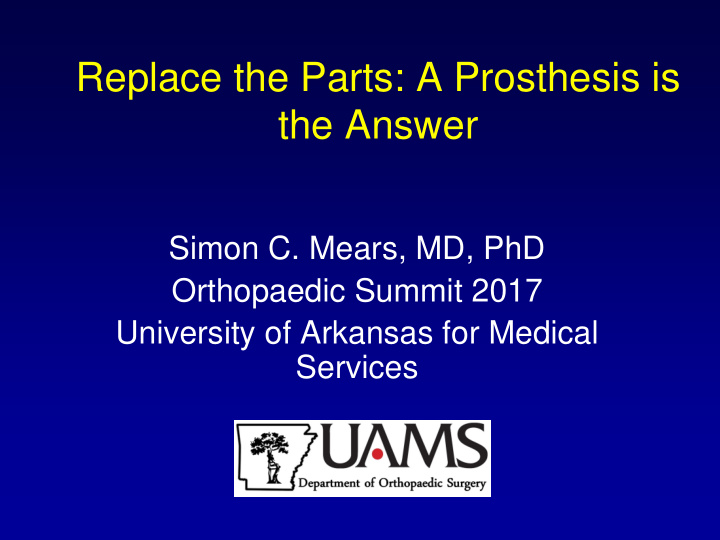



Replace the Parts: A Prosthesis is the Answer Simon C. Mears, MD, PhD Orthopaedic Summit 2017 University of Arkansas for Medical Services
Disclosure • Deputy Editor: Geriatric Orthopaedic Surgery and Rehabilitation • Past President: International Geriatric Fracture Society
Geriatric acetabular fractures • A disaster • With some fracture patterns, fixation doesn’t work well
Poor prognosis for ORIF • Posterior wall fractures • Complex fractures • Age • Poor bone quality • Comminution • Femoral head damage • Prolonged dislocation • Late surgery
Posterior wall fractures over age 40 • Fixation is fraught with difficulty • Very high reoperation rates • No weight bearing after surgery • Often require a delayed THA
So why do 2 when you can do one • If the hip is doomed, why fix it • Just replace it
Options • Percutaneous fixation • ORIF • Delayed THA • Acute THA (some requiring combined ORIF)
Acute THA results • Dana Mears • Results overall good • Limited case series • Some authors use cage fixation
Acute THA • Complication rates higher that primary THA • Heterotopic ossification • Sciatic nerve injury • Infection • Dislocation • Acetabular loosening
Total hip for acute acetabular fracture • Pure posterior fractures • Complex fractures: transverse with posterior wall • Anterior fractures, most often with protrusio
Pure posterior wall fractures • A relatively easy total hip • Often can ream in further and use a primary cup with screws • If a defect use an augment either femoral head or metal
Complex posterior wall • Must fix and replace • Posterior plate • Then cup fixation with screws • Have an augment as backup
The plate fixation is easy • Reduction does not have to be perfect • Just enough to be stable to place a cup
How to do • One surgeon or two • Depends on skill of surgeons • In most cases trauma surgeon does the ORIF • Joint surgeon does the replacement
Anterior fractures • If pure medial then use the head as bone graft and place cup • Otherwise place anterior plate first
Timing • Total hip must be done at the right time • Delay if you are concerned • Do not operative through morel lesions
Delay • Results will also be good if performed 2-3 months later • Mobilize and do the hip later • Even true if the hip is unstable
Remember the worst result • The infected ORIF with heterotopic ossification • Then you can’t do the total hip • Better off waiting and doing a delayed total hip than getting an infected ORIF
Technical difficulties: Instability • The capsule has been ripped off posteriorly • Higher dislocation rates • Do your best to fix it, use largest head or dual mobility
Technical difficulties: The cup • If also fixing then you use a bean bag for fluoro, this gives less secure positioning of pelvis • Can be fooled by lack of posterior wall and put the acetabulum in retroversion
Technical difficulties: Fixation • Use revision components • Place as many screws as possible • Augment on backup • Cage on backup
Conclusion Prosthesis is the answer Many acetabular fractures have poor outcomes If there is posterior wall injury, femoral head injury or marked protrusio results are poor with ORIF as patients get older These should be replaced, with great care Replacement may need to be combined with ORIF or delayed
Thank You
References • Mears DC, Velyvis JH, Chang CP. Displaced acetabular fractures managed operatively: indicators of outcome. Clin Orthop Relat Res. 2003 Feb;(407):173-86. • Mears DC, Velyvis JH. Acute total hip arthroplasty for selected displaced acetabular fractures: two to twelve-year results. J Bone Joint Surg Am. 2002 Jan;84-A(1):1-9. • Solomon LB, Studer P, Abrahams JM, Callary SA, Moran CR, Stamenkov RB, Howie DW. Does cup-cage reconstruction with oversized cups provide initial stability in THA for osteoporotic acetabular fractures ? Clin Orthop Relat Res. 2015 Dec;473(12):3811-9. Lin C, Caron J, Schmidt AH, Torchia M, Templeman D. Functional outcomes after total hip arthroplasty for the acute management of acetabular fractures : 1- to 14-year follow-up. J Orthop Trauma. 2015 Mar;29(3):151-9. • Enocson A, Blomfeldt R. Acetabular fractures in the elderly treated with a primary Burch-Schneider reinforcement ring, autologous bone graft, and a total hip arthroplasty: a prospective study with a 4-year follow- up. J Orthop Trauma. 2014 Jun;28(6):330-7. • O'Toole RV, Hui E, Chandra A, Nascone JW. How often does open reduction and internal fixation of geriatric acetabular fractures lead to hip arthroplasty? J Orthop Trauma. 2014 Mar;28(3):148-53.
Recommend
More recommend